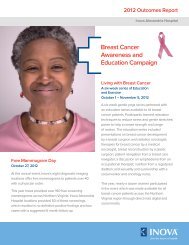what can we do to prevent childhood obesity? - Zero to Three
what can we do to prevent childhood obesity? - Zero to Three
what can we do to prevent childhood obesity? - Zero to Three
You also want an ePaper? Increase the reach of your titles
YUMPU automatically turns print PDFs into web optimized ePapers that Google loves.
other words, as <strong>we</strong> have come <strong>to</strong> recognize that with<br />
respect <strong>to</strong> most aspects of child development, the old<br />
dicho<strong>to</strong>my of nature versus nurture represents an oversimplification<br />
of a complex issue.<br />
We <strong>do</strong> know that the dramatic increase in the prevalence<br />
of over<strong>we</strong>ight in the general population and among<br />
children since 1990 absolutely <strong>can</strong>not be accounted for by<br />
genetic shifts in the population. Genetic changes simply <strong>do</strong><br />
not occur this quickly. It is possible,<br />
ho<strong>we</strong>ver, that genetic predispositions<br />
<strong>to</strong>ward certain behaviors<br />
(e.g., preferences for s<strong>we</strong>et or highfat<br />
foods) vary within the population.<br />
When the environment<br />
changes, these genetic predispositions<br />
may be more apt <strong>to</strong> express themselves than formerly;<br />
the result is over<strong>we</strong>ight or <strong>obesity</strong>. The overarching message?<br />
Our genes have not changed recently; our environment<br />
has. What <strong>do</strong>es this conclusion tell us about the<br />
strong transmission of over<strong>we</strong>ight risk from parent <strong>to</strong> child?<br />
Parents’ modeling of behavior and their shaping of a<br />
child’s relationship <strong>to</strong> food have been areas of active<br />
research in child development for quite some time.<br />
Accounts in the lay press <strong>do</strong> not hesitate <strong>to</strong> hold parents<br />
responsible for <strong>childhood</strong> over<strong>we</strong>ight. For example, recent<br />
articles in national newspapers have been headlined, “Over<strong>we</strong>ight<br />
kids? You might deserve a big slice of the<br />
blame”(Lee, 2004), or “If parents <strong>can</strong>’t say no, then their<br />
children won’t learn <strong>to</strong> either” (Hart, 2003). Blaming parents<br />
for a problem that is growing more quickly—and at epidemic<br />
proportions—in disadvantaged minority populations<br />
than in the population as a whole immediately raises concerns<br />
about the validity of this conceptualization of the<br />
problem. If parents are generally and primarily <strong>to</strong> blame for<br />
the increased prevalence of child over<strong>we</strong>ight since 1990,<br />
one or both of the following statements would have <strong>to</strong> be<br />
true: (a) Parenting practices as a whole have shifted dramatically<br />
in the last 15 years, and (b) low-income parents (especially<br />
mothers) have a reasonable chance of overcoming the<br />
influence of both food advertising that is targeted at their<br />
children and the economic conditions in which they live.<br />
Who Influences Children’s Eating<br />
Behavior?<br />
If poor parenting is <strong>to</strong> blame for the growing prevalence<br />
of <strong>childhood</strong> <strong>obesity</strong>, then something must have changed<br />
since 1990 in the ways in which parents teach their children<br />
about food, set limits around food, and promote<br />
healthy eating habits. This assertion is difficult <strong>to</strong> support,<br />
for a variety of reasons. For example, if parents have a po<strong>we</strong>rful<br />
influence over children’s eating behavior and development<br />
of food preferences, then family members’ food<br />
preferences should be very much alike. In fact, very little<br />
correlation exists bet<strong>we</strong>en parent and child food preferences<br />
(even when the children have grown <strong>to</strong> be adults;<br />
Today’s over<strong>we</strong>ight children tend<br />
<strong>to</strong> be heavier than over<strong>we</strong>ight<br />
children <strong>we</strong>re in past years.<br />
Rozin, 1991). Parents are not very effective at transmitting<br />
preferences for foods <strong>to</strong> their children (a finding that will<br />
not surprise any parent or caregiver who has struggled <strong>to</strong><br />
encourage a child <strong>to</strong> sample a new food!).<br />
Although parents have limited control over <strong>what</strong> children<br />
are willing <strong>to</strong> eat while sitting at the dinner table parents<br />
<strong>do</strong> control <strong>what</strong> food is in the cupboards. Given that<br />
<strong>obesity</strong> is more common in low-income minority populations,<br />
perhaps efforts should focus<br />
on encouraging low-income mothers<br />
with young children <strong>to</strong> s<strong>to</strong>ck<br />
the house with a range of healthy<br />
food options for their children.<br />
Unfortunately, this recommendation<br />
is problematic from a public<br />
health perspective. Consider, for example, the research finding<br />
that families who live closer <strong>to</strong> supermarkets are more<br />
likely <strong>to</strong> consume a healthier diet than are families who live<br />
further away, presumably because those living closer have<br />
readier access <strong>to</strong> a range of fresh and healthy foods (Morland,<br />
Wing, & Roux, 2002). Ho<strong>we</strong>ver, the number of supermarkets<br />
per capita is nearly 6 times greater in White<br />
neighborhoods than it is in neighborhoods of primarily<br />
minority race/ethnicity (Morland, Wing, Roux, & Poole,<br />
2002). The reasons for these stark disparities are un<strong>do</strong>ubtedly<br />
complex, and not fully unders<strong>to</strong>od. These differences,<br />
ho<strong>we</strong>ver, would potentially be amenable <strong>to</strong> public policy<br />
intervention.<br />
Where <strong>do</strong> children learn their food preferences? The<br />
bulk of the evidence suggests that even children as young<br />
as 2 years learn food preferences from their peer group. In<br />
one study, researchers in a preschool setting seated children<br />
who didn’t like broccoli next <strong>to</strong> children who did.<br />
The broccoli eaters ate their green vegetable in full view of<br />
their broccoli-averse classmates. Over time, the children<br />
who hadn’t liked broccoli began <strong>to</strong> eat it (Birch, 1980). In<br />
a more recent experiment, teachers in a preschool setting<br />
and peer models <strong>we</strong>re put head-<strong>to</strong>-head <strong>to</strong> determine who<br />
was more likely <strong>to</strong> influence a child’s food preferences. The<br />
children <strong>we</strong>re signifi<strong>can</strong>tly more po<strong>we</strong>rful influences than<br />
the adults <strong>we</strong>re (Hendy & Raudenbush, 2000).<br />
Evolutionary biology suggests two principal reasons why<br />
peers may be more po<strong>we</strong>rful than adults in shaping children’s<br />
food preferences:<br />
• Young children’s reluctance <strong>to</strong> sample new foods is<br />
biologically wired. Reluctance <strong>to</strong> try new foods begins<br />
<strong>to</strong> emerge at around age 2 years and lessens as children<br />
approach school age. The unfamiliar foods that children<br />
are most reluctant <strong>to</strong> try are vegetables (Cooke, Wardle,<br />
& Gibson, 2003). That children become reluctant <strong>to</strong><br />
sample new foods just as they are becoming mobile,<br />
independent explorers seems <strong>to</strong> be more than mere<br />
coincidence. It would be <strong>to</strong> the human species’ survival<br />
advantage for its young <strong>to</strong> be reluctant <strong>to</strong> eat unfamiliar<br />
ZERO TO THREE<br />
January 2005<br />
15

















